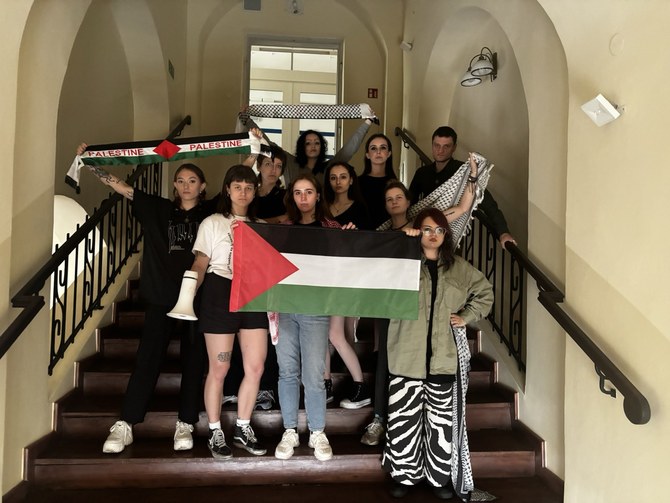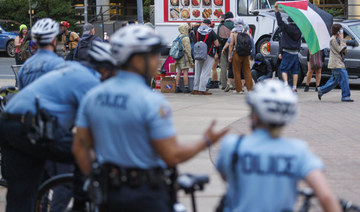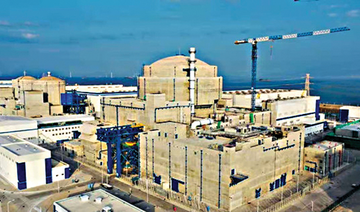WARSAW: Polish students have joined the global movement to end partnerships with Israeli institutions and were occupying the country’s top campuses on Saturday because of Israel’s war on Gaza.
Students and alumni of 12 universities in Poland have been calling on their management to publicly disclose which Israeli academia, research centers, organizations and companies they have been cooperating with and in what scope.
In open letters to rectors, they demanded that the universities “boycott Israeli institutions at the national and international level until the occupation of Palestine ends, recognize the right of Palestinians to equality and self-determination, and recognize the right of return for Palestinian refugees.”
As no action followed from university authorities, on Friday evening they set up encampments at the campuses of the University of Warsaw — the country’s largest academic institution — and of the Jagiellonian University — the oldest and most prestigious.
In a joint manifesto, the protesters said: “We will occupy the university space with our own bodies to demand action ... we consider opposing genocide as our highest obligation.”
Israeli airstrikes and ground offensives in Gaza have since October killed 36,000 Palestinians with more than 80,000 wounded, the vast majority children and women. Many have lost their lives as most of the hospitals have been flattened by bombardment and no medical assistance could reach them.
Protesting students say that failing to oppose the onslaught would mean tacit consent — and complicity.
The University of Warsaw is linked through a research project to the Ben-Gurion University, whose Homeland Security Institute partners with the biggest Israeli arms manufacturers such as Elbit Systems, Rafael Advanced Defense Systems and the Israeli Ministry of Defense. It is also linked to the University of Haifa, which runs special programs for Israeli forces and intelligence.
“As a student, I feel I should have a say in what our university is investing and what its partners are. We know that the university is tied to the Israeli army, forces and apartheid system,” Agnieszka, a sociology student and one of the coordinators of the strike at the University of Warsaw, told Arab News.
“That’s why I’m here ... I hope it will change something.”
Agnieszka was speaking from behind the university gate, which has been locked since Friday evening as campus authorities sealed all entry points, preventing anyone from leaving or getting inside.
People were coming to the gate and the campus fence to bring the students water, food and power banks, and to show support.
While no one could join their encampment anymore, the dozens of students gathered inside believed they could bring change.
“We’ve been protesting since October against the genocide that is occurring in Gaza, and now we’re sort of bringing it closer,” said Nena, who studies at the Faculty of Philosophy.
“We have more direct impact on the institutions we are part of.”
At the same time, 300 km away, students of the Jagiellonian University in Krakow were also locked up at their campus, posing the same demands as those in Warsaw, and vowing that they “will not be indifferent, will not be silent, will not be passive,” as they called for others to join.
“It’s important for me to be here,” Gabriela, an international relations student told Arab News from the Krakow protest site. “It’s important to show solidarity with other encampments around the world, so that authorities can’t ignore our demands any longer.”
The University of Warsaw and the Jagiellonian University have not engaged in any discussions with the protesters. Neither university commented on whether it would agree to the students’ demands. The spokesperson of the Jagiellonian University said that to “ensure the safety of the strike participants,” there was a person “appointed to monitor the situation.”
Polish students occupy top universities to cut ties with Israeli academia
https://arab.news/42ssw
Polish students occupy top universities to cut ties with Israeli academia

- Students set up encampments at the University of Warsaw and Jagiellonian University
- ‘We consider opposing genocide as our highest obligation,’ students say
Strong winds, steep terrain hamper crews battling Los Angeles area’s first major fire of the year

- Los Angeles County’s first major wildfire of the year swiftly grew to nearly 60 square kilometers
- The blaze, dubbed the Post Fire, was just two percent contained Sunday evening
Los Angeles County’s first major wildfire of the year swiftly grew to nearly 23 square miles (60 square kilometers), one day after it forced the evacuation of at least 1,200 campers, off-roaders and hikers from the Hungry Valley recreation area.
The blaze, dubbed the Post Fire, was just 2 percent contained Sunday evening. No injuries were reported. The cause was under investigation.
Firefighters working in sweltering conditions and steep terrain raced to douse spot fires that erupted as unpredictable winds blew embers ahead of the flames, said Kenichi Haskett, a section chief for the LA County Fire Department. The gusts also hampered efforts by aircraft crews to drop water and fire retardant, he said.
“When it’s windy, it just sprays the water everywhere we don’t need it. So that’s a challenge,” Haskett said.
Meanwhile in Northern California, a small wildfire sparked Sunday prompted evacuation orders and warnings for a sparsely populated area near Lake Sonoma. The so-called Point Fire sent up a huge plume of dark smoke as it churned through brush and timber about 80 miles (130 kilometers) north of San Francisco. It was 15 percent contained.
The Southern California fire erupted Saturday afternoon near I-5 in Gorman, about 60 miles (100 kilometers) northwest of Los Angeles. Two structures burned within the evacuated recreation area.
Flames were moving toward Pyramid Lake, a popular destination for boaters that was closed as a precaution on Father’s Day. No houses were threatened Sunday, but officials warned residents of Castaic, home to about 19,000 people, that they should prepare to leave if the fire pushes further south.
“If you’re in a warning area, be prepared with a ‘go bag,’ with overnight clothes and your cellphone, your medicines, your glasses. Have your car fueled up,” said Haskett. “Be ready to evacuate.”
Low humidity and gusts around 50 mph (80 kph) were expected throughout the day, and winds could pick up speed after sundown, warned the National Weather Service office for Los Angeles.
About 75 miles (120 kilometers) to the east, the nearly 2-square-mile (5-square-kilometer) Hesperia Fire forced road closures and prompted evacuation warnings after it broke out Saturday near mountain communities in San Bernardino County. The blaze was 19 percent contained Sunday evening.
Muslims in Asia celebrate Eid Al-Adha with sacrifice festival and traditional feast

- On Monday, worshippers shoulder-to-shoulder joined in communal prayers in Indonesia’s capital, Jakarta
- Preachers in their sermons called on people to pray for Muslims in Gaza and Rafah
JAKARTA: Muslims in Asia on Monday celebrated Eid Al-Adha, or the Feast of Sacrifice, with food and prayers for people in Gaza suffering from the Israel-Hamas war.
One of the biggest Islamic holidays, the occasion commemorates Prophet Ibrahim’s test of faith through slaughtering livestock and animals and distributing the meat to the poor. It’s a joyous occasion for which food is a hallmark where devout Muslims buy and slaughter animals and share two-thirds of the meat with the poor and it’s a revered observance that coincides with the final rites of the Hajj pilgrimage in Saudi Arabia.
Much of Asia, including Indonesia, Malaysia, India and Bangladesh, observed Eid Al-Adha on Monday, while Muslims in other parts of the globe, including Saudi Arabia, Libya, Egypt, and Yemen celebrated the holiday on Sunday.
On Monday, worshippers shoulder-to-shoulder joined in communal prayers in Indonesia’s capital, Jakarta. Preachers in their sermons called on people to pray for Muslims in Gaza and Rafah.
“Our prayers and thoughts are with our brother and sisters who are now suffering in Palestine,” worshipper Adi Prasetya said after praying at a field in southern Jakarta. “There are many opportunities for us now to channel our help through charities.”
“May Allah give strength to those ravaged by war... may those who are divided can live in peace again,” said another devotee, Berlina Yustiza.
Although Indonesia has more Muslims than any other country in the world, its traditions to mark Eid Al-Adha have been influenced by other religions.
Residents in Yogyakarta, an ancient center of Javanese culture and the seat of royal dynasties going back centuries, believe that if they manage to catch the crops arranged in the form of a cone-shaped pile called “gunungan” that is paraded from the royal palace to the Kauman Grand Mosque, it can bring them good luck. They scrambled to grab various food offerings, made of fruit, vegetables and traditional snacks.
A day before the sacrifice festival, people in East Java’s Pasuruan city expressed their gratitude and respect for the sacrificial animals by dressing them as beautiful as a bride. The sacrificial cow is wrapped in a seven-fold garland, a shroud, turban and prayer mat and paraded in a tradition called “manten sapi,” or bride cow, before being handed to the sacrificial committee.
Villagers in Demak, a town in Central Java province, celebrated the holiday with a procession of livestock called “apitan” as a form of gratitude for the food and harvest. They bring foods in bamboo containers to the town’s square that they eat together after praying. Locals believe the procession will provide prosperity and that disaster would come if it was abandoned.
Eid Al-Adha commemorates the Qur’anic tale of Ibrahim’s willingness to sacrifice Ismail as an act of obedience to God. Before he could carry out the sacrifice, God provided a ram as an offering. In the Christian and Jewish telling, Abraham is ordered to kill another son, Isaac.
In Malaysia, Prime Minister Anwar Ibrahim joined thousands of congregants, including foreign tourists, and offered morning prayers at a mosque near his office in Putrajaya, south of the capital Kuala Lumpur.
Meanwhile at a wholesale market in Selayang, just outside the capital, Muslim workers there knelt on mats placed on a large piece of white cloth laid outside the market to perform their prayers.
In his message, Anwar said the opportunity to go on the Hajj pilgrimage to Makkah is one of God’s great gifts and should make one more ascetic and simpler.
“I invite Muslims to live the message of simplicity that is preached in Hajj, to always be humble and not be mesmerized by the attraction of temporary worldly riches,” Anwar said, “Let’s not deviate from this goal. The world should be a bridge to the eternal land.”
US as many as 15 years behind China on nuclear power, report says

- China has 27 nuclear reactors under construction with average construction timelines of about seven years
- A high-tech plant that had been planned to be built at a US lab was canceled last year
WASHINGTON: The US is as many as 15 years behind China on developing high-tech nuclear power as Beijing’s state-backed technology approach and extensive financing give it the edge, a report said on Monday.
China has 27 nuclear reactors under construction with average construction timelines of about seven years, far faster than other countries, said the study by Information Technology & Innovation Foundation, a Washington-based nonpartisan research institute.
“China’s rapid deployment of ever-more modern nuclear power plants over time produces significant scale economies and learning-by-doing effects, and this suggests that Chinese enterprises will gain an advantage at incremental innovation in this sector going forward,” the report said.
The US has the world’s largest fleet of nuclear power plants and President Joe Biden’s administration considers the virtually emissions-free electricity source to be critical in curbing climate change.
But after two large plants in Georgia came online in 2023 and 2024 billions of dollars over budget and delayed by years, no US nuclear reactors are being built. A high-tech plant that had been planned to be built at a US lab was canceled last year.
China’s state-owned banks can offer loans as low as 1.4 percent, far lower than available in Western economies. Its nuclear power industry has benefited from sustained state support and localization strategies that has allowed China to dominate sectors like renewable power and EVs.
The world’s first so-called fourth-generation high-temperature gas cooled reactor at Shidao Bay came online last December. The China Nuclear Energy Association claims that the project involved the development of more than 2,200 sets of “world-first equipment” with a total localization rate of domestically produced materials of 93.4 percent.
Backers of high-tech reactors say they are safer and more efficient than current plants. Critics say some new reactors introduce proliferation and material risks.
It has not all been smooth sailing for China. The China Nuclear Energy Association has warned that there was a severe glut in nuclear component production, and “excessive competition” was driving down prices and causing losses.
Stephen Ezell, the report’s author, said if the US is serious about nuclear it should develop a robust national strategy involving more investment in research and development, identifying and accelerating promising technologies, and supporting development of a skilled workforce.
“While America is behind, it can certainly catch up technologically,” said Ezell.
The US Department of Energy did not comment on the report.
Chinese premier agrees with Australia to ‘properly manage’ differences

- Australia shares US concerns over China’s global dominance in critical minerals and control over supply chains in the renewable energy sector
MELBOURNE: Chinese Premier Li Qiang said he had agreed with Australia’s Prime Minister Anthony Albanese on Monday to properly manage their nations’ differences as they emerge from a hostile era in which minister-to-minister contacts were banned and trade barriers cost Australian exporters up to $13 billion (20 billion Australian dollars) a year.
Li, Albanese and senior ministers of both administrations met at Parliament House on Monday to discuss thorny issues, including lingering trade barriers, conflict between their militaries in international waters and China’s desire to invest in critical minerals.
Li, China’s most senior leader after President Xi Jinping, arrived in the South Australian state capital of Adelaide on Saturday and the national capital of Canberra late Sunday in the first visit to the country by a Chinese premier in seven years.
Li told reporters said after Monday’s meeting that the bilateral relationship was “on the right track of steady improvement and development.”
“We ... had a candid exchange of views on some differences and disagreements and agreed to properly manage them in a manner befitting our comprehensive strategic partnership,” Li said through an interpreter.
Albanese described the discussions as “constructive.”
“Australia advocates that we should all work together to promote a regional balance where no country dominates and no country is dominated,” Albanese said.
“I’ve made it clear as nations with different histories, political systems and values, we will cooperate with China where we can, disagree where we must and engage in the national interest,” Albanese added.
Bilateral relations have improved markedly since Albanese’s center-left Labour Party was elected in 2022 following nine years of conservative government in Australia.
Most of the official and unofficial trade barriers Beijing introduced in 2020 on coal, cotton, wine, barley and wood have been lifted since Albanese was elected.
Beijing had banned minister-to-minister contacts as it froze out the previous Australian government diplomatically.
Agriculture Minister Murray Watt said before the leaders’ meeting Monday that he would raise the issue of China’s ban on Australian rock lobsters and exports from two beef processing plants.
“The mere fact that we have the first visit by a Chinese premier, the second-most powerful person in China, ... since 2017 is an enormous opportunity to continue that dialogue, to continue stabilizing our relationship and address some of the outstanding issues,” Watt said.
Li planned to underscore China’s interest in buying a bigger stake in Australia’s critical minerals sector, which is essential to the global transition to renewable energy sources, by visiting a Chinese-controlled lithium processing plant in Western Australia state Tuesday.
Li visited New Zealand before Australia and is scheduled to stop in Malaysia late Tuesday before returning to China.
Australia shares US concerns over China’s global dominance in critical minerals and control over supply chains in the renewable energy sector.
Citing Australia’s national interests, Treasurer Jim Chalmers recently ordered five Chinese-linked companies to divest their shares in the rare earth mining company Northern Minerals.
Watt said Chinese investment was not banned from the sector, but must meet national security criteria.
Albanese’s office said the prime minister would tell Li at a state lunch that the “points on which we disagree won’t disappear if we leave them in silence.”
This appears to be in response to a statement by Li, released by the Chinese Embassy in Canberra on Sunday, that he recommended “shelving differences” between the two countries in the interests of bolstering relations.
Earlier, Albanese had said he would raise with Li recent clashes between the two countries’ militaries in the South China Sea and Yellow Sea that Australia argues endangered Australian personnel.
Relations tumbled over Australian legislation that banned covert foreign interference in Australian politics, the exclusion of Chinese-owned telecommunications giant Huawei from rolling out the national 5G network due to security concerns, and Australia’s call for an independent investigation into the causes of and responses to the COVID-19 pandemic.
Benjamin Herscovitch, a China expert at Australian National University, said he did not expect China to get any firm commitments from Australia during Li’s visit.
But Australia had already made a concession to China in rebuilding relations through inaction by not imposing sanctions on Chinese entities that help Russia’s war effort in Ukraine, he said.
“Australia is essentially giving China a free pass on that issue,” Herscovitch said, while Australian allies, including the United States were imposing sanctions.
Hundreds of pro-China demonstrators, human rights activists and democracy advocates have lined the routes of Li’s cavalcades in Adelaide and Canberra.
Thousands of Rohingya feared trapped in fighting in western Myanmar

- Residents of Maungdaw town, inhabited primarily by the Rohingya, told to leave ahead of a planned offensive by the Arakan Army against Myanmar ruling junta forces
Tens of thousands of Muslim minority Rohingya are feared to be caught in fighting in western Myanmar, as a powerful armed ethnic group bears down on junta positions in a coastal town on the country’s border with Bangladesh.
The Arakan Army (AA), which is fighting for autonomy for Myanmar’s Rakhine region, said late on Sunday that residents of Maungdaw town, inhabited primarily by the Rohingya, should leave by 9 p.m. ahead of a planned offensive on the settlement.
The AA’s attack on Maungdaw is the latest in a months-long rebel onslaught against the Myanmar junta, which took power in a February 2021 coup, and now finds itself in an increasingly weakened position across large parts of the country.
“We are going to attack the remaining posts” of junta, the AA said in a statement, asking residents to stay clear of military positions in Maungdaw for their own safety.
A junta spokesman did not respond to a call seeking comment.
Around 70,000 Rohingya who are currently in Maungdaw are trapped as the fighting draws closer, said Aung Kyaw Moe, the deputy human rights minister in Myanmar’s shadow National Unity Government.
“They have no where to run to,” he told Reuters.
Thousands of Rohingya fled toward neighboring Bangladesh last month, seeking safety from the escalating conflict, although the neighboring country is reluctant to accept more refugees.
Their movement was triggered by battles in and around the town of Buthidaung, around 25 km (15 miles) away to the east of Maungdaw, that was captured by the AA after intense fighting during which the rebel group was accused of targeting the Rohingya community.
The AA denies the allegations.
Rohingya have faced persecution in Buddhist-majority Myanmar for decades. Nearly a million of them live in refugee camps in Bangladesh’s border district of Cox’s Bazar after fleeing a military-led crackdown in Rakhine in 2017.




















